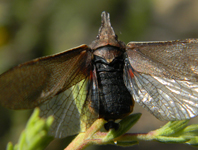Abstract
Pseudoamycle polylepisae gen. et sp. nov. is described from northernmost Chile (Arica and Parinacota Region). It is characterized by the small and brown body, head with no preocular flange, cephalic process porrect and dorsoventrally compressed, dorsal surface from lateral view not angulate at level of eyes, eyes round, tegmina concolorous and vein MP of tegmen pectinate. The new taxon was found to be associated with Polyepis rugulosa Bitter (Rosaceae).
References
Anufriev, G.A. & Emeljanov, A.F. (1988) Suborder Cicadinea (Auchenorrhyncha). In: Ler, P.A. (Ed.), Keys to the insects of the Far East of the USSR in six volumes. Vol. II. Homoptera and Heteroptera. URSS, Nauka, Leningrad, pp. 12–495.
Barringer, L.E., Donovall, L.R., Spichiger, S.E., Lynch, D. & Henry, D. (2015) The first new world record of Lycorma delicatula (Insecta: Hemiptera: Fulgoridae). Entomological News, 125 (1), 20–23.
https://doi.org/10.3157/021.125.0105
Bartlett, C.R., O'Brien, L.B. & Wilson, S.W. (2014) A review of the planthoppers (Hemiptera: Fulgoroidea) of the United States. Memoirs of the American Entomological Society, 50, 1–287.
Bartlett, C.R., Deitz, L.L., Dmitriev, D.A., Sanborn, A.F., Soulier-Perkins, A. & Wallace, M.S. (2018) The Diversity of the True Hoppers (Hemiptera: Auchenorrhyncha). In: Footit, R.G. & Adler, P.H. (Eds.), Insect Biodiversity: Science and Society. Vol. II. John Wiley & Sons, Chichester, pp. 501–590.
https://doi.org/10.1002/9781118945582.ch19
Bourgoin, T. (1993) Female genitalia in Hemiptera Fulgoromorpha, morphological and phylogenetical data. Annales de la Société Entomologique de France, Nouvelle Série, 29 (3), 225–244.
Bourgoin, T. (2018) FLOW (Fulgoromorpha Lists on The Web): a world knowledge base dedicated to Fulgoromorpha. Version 8. Available from: http://hemiptera-databases.org/flow (accessed 17 February 2018)
Bourgoin, T., Wang, R.R., Asche, M., Hoch, H., Soulier-Perkins, A., Stroiński, A., Yap, S. & Szwedo, J. (2015) From micropterism to hyperpterism: recognition strategy and standardized homology-driven terminology of the forewing venation patterns in planthoppers (Hemiptera: Fulgoromorpha). Zoomorphology, 134 (1), 63–77.
https://doi.org/10.1007/s00435-014-0243-6
Brako, L. & Zarucchi, J.L. (1993). Catalogue of the Flowering Plants and Gymnosperms of Peru. Monographs in Systematic Botany from the Missouri Botanical Garden, 45, 1–1286.
Caldwell, J.S. (1945) Neotropical lanternflies of the genus Phrictus in the United States National Museum, with descriptions of four new species. Proceedings of the United States National Museum, 96 (3194), 177–184.
https://doi.org/10.5479/si.00963801.96-3194.177
Eastop, V.F. (1972) Deductions from the present day host-plants of aphids and related insects. Symposia of the Royal Entomological Society of London, 6, 157–178.
Emeljanov, A.F. (1979) The problem of family distinction between the Fulgoridae and the Dictyopharidae (Homoptera, Auchenorrhyncha). Trudy Zoologicheskogo Instituta, 82, 3–22.
Emeljanov, A.F. (2011) Improved tribal delimitation of the subfamily Dictyopharinae and description of new genera and new species (Homoptera, Fulgoroidea, Dictyopharidae). Entomological Review, 91 (9), 1122–1145.
https://doi.org/10.1134/S0013873811090053
Johnson, L. & Foster, R. (1986) Associations of Large Homoptera (Fulgoridae and Cicadidae) and Trees in a Tropical Forest. Journal of the Kansas Entomological Society, 59, 415–422.
Kessler, M. & Schmidt-Lebuhn, A. (2006) Taxonomical and distributional notes on Polylepis (Rosaceae). Organism, Diversity & Evolution, 13, 1–10.
https://doi.org/10.1016/j.ode.2005.04.001Kowoll, M. (1993) Antecedentes y caracterización de las poblaciones de queñoa (Polylepis besseri Hieron.) entre Chapiquiña y Tignamar en la precordillera de la I Región. Tesis de grado Ingeniero Forestal. Universidad de Chile, Facultad de Ciencias Agrarias, Santiago, 107 pp.
Ministerio Secretaría General de la Presidencia (2008) D.S. N°51/2008. Aprueba y oficializa nómina para el tercer proceso de clasificación de especies según su estado de conservación. Diario Oficial de la República de Chile, 39100, 4–5.
O'Brien, L.B. (1988) New World Fulgoridae, part I: genera with elongate head processes. Great Basin Naturalist Memoirs, 12, 135–170.
https://doi.org/10.5962/bhl.part.10985
Renison, D., Henesen, I. & Cingolani, A.M. (2004) Anthropogenic soil degradation affects seed viability in Polylepis australis mountain forests of central Argentina. Forest Ecology and Management, 196, 327–333.
https://doi.org/10.1016/j.foreco.2004.03.025
Schmidt-Lebuhn, A., Kumar, M. & Kessler, M. (2006) An assessment of the genetic population structure of two species of Polylepis Ruiz et Pav. (Rosaceae) in the Chilean Andes. Flora, 201, 317–325.
https://doi.org/10.1016/j.flora.2005.07.007
Signoret, V. (1863) Révision des Hémiptères du Chili. Annales de la Société Entomologique de France, Series 4, 3, 541–588.
Silva, P. (1944) Insect pests of cacao in the State of Bahia, Brazil. Tropical Agriculture, 21 (1), 8–14.
Song, Z.S., Bourgoin, T. & Liang, A.P. (2011) Review of the Oriental monotypic genus Pibrocha Kirkaldy (Hemiptera, Fulgoromorpha, Fulgoridae, Dorysarthrinae). ZooKeys, 132, 1–12.
https://doi.org/10.3897/zookeys.132.1319
World Conservation Monitoring Centre (1998) Polylepis rugulosa. The IUCN Red List of Threatened Species, 1998, e.T37152A10037017.
https://doi.org/10.2305/IUCN.UK.1998.RLTS.T37152A10037017.en

